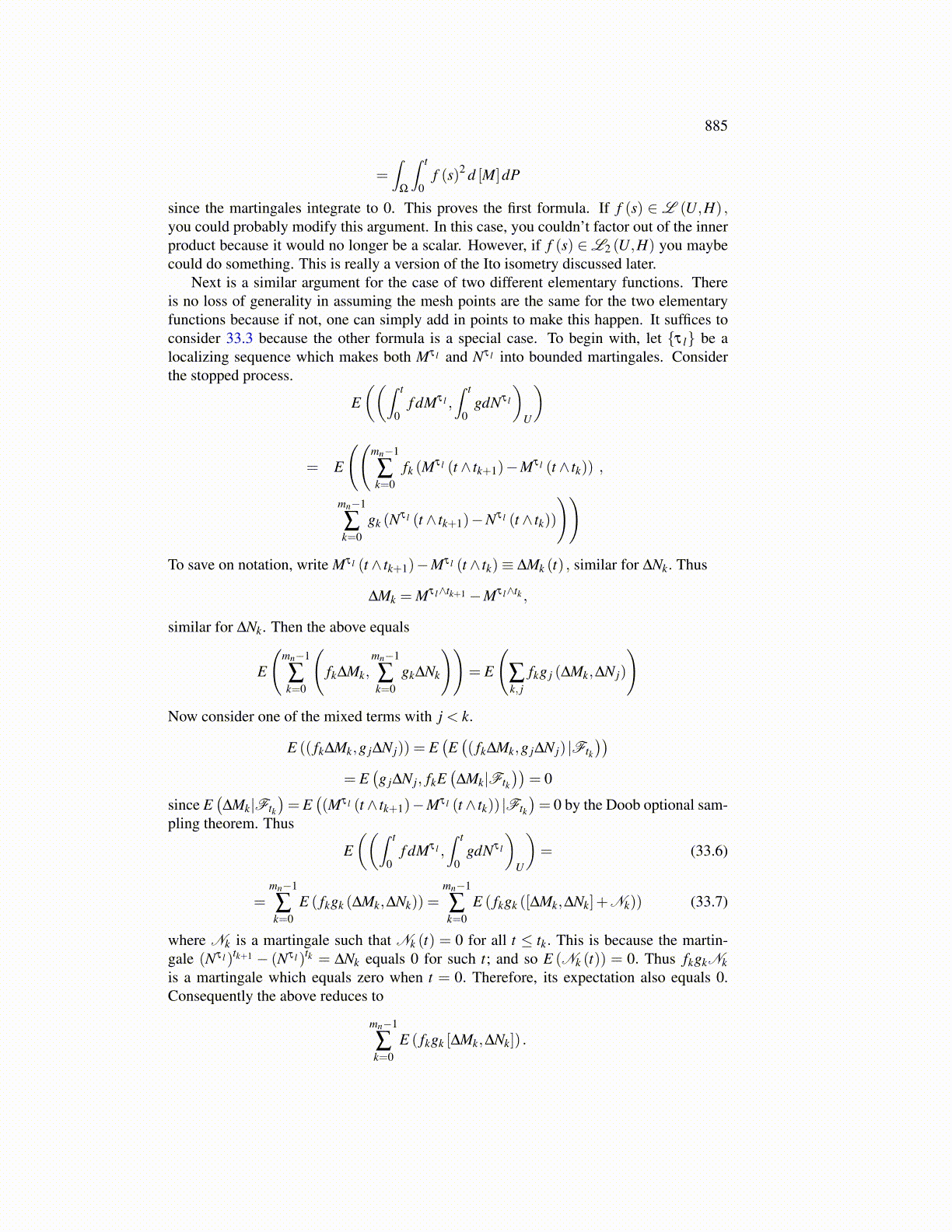
885
=∫
Ω
∫ t
0f (s)2 d [M]dP
since the martingales integrate to 0. This proves the first formula. If f (s) ∈ L (U,H) ,you could probably modify this argument. In this case, you couldn’t factor out of the innerproduct because it would no longer be a scalar. However, if f (s) ∈L2 (U,H) you maybecould do something. This is really a version of the Ito isometry discussed later.
Next is a similar argument for the case of two different elementary functions. Thereis no loss of generality in assuming the mesh points are the same for the two elementaryfunctions because if not, one can simply add in points to make this happen. It suffices toconsider 33.3 because the other formula is a special case. To begin with, let {τ l} be alocalizing sequence which makes both Mτ l and Nτ l into bounded martingales. Considerthe stopped process.
E((∫ t
0f dMτ l ,
∫ t
0gdNτ l
)U
)
= E
((mn−1
∑k=0
fk (Mτ l (t ∧ tk+1)−Mτ l (t ∧ tk)) ,
mn−1
∑k=0
gk (Nτ l (t ∧ tk+1)−Nτ l (t ∧ tk))
))To save on notation, write Mτ l (t ∧ tk+1)−Mτ l (t ∧ tk)≡ ∆Mk (t) , similar for ∆Nk. Thus
∆Mk = Mτ l∧tk+1 −Mτ l∧tk ,
similar for ∆Nk. Then the above equals
E
(mn−1
∑k=0
(fk∆Mk,
mn−1
∑k=0
gk∆Nk
))= E
(∑k, j
fkg j (∆Mk,∆N j)
)Now consider one of the mixed terms with j < k.
E (( fk∆Mk,g j∆N j)) = E(E(( fk∆Mk,g j∆N j) |Ftk
))= E
(g j∆N j, fkE
(∆Mk|Ftk
))= 0
since E(∆Mk|Ftk
)= E
((Mτ l (t ∧ tk+1)−Mτ l (t ∧ tk)) |Ftk
)= 0 by the Doob optional sam-
pling theorem. Thus
E((∫ t
0f dMτ l ,
∫ t
0gdNτ l
)U
)= (33.6)
=mn−1
∑k=0
E ( fkgk (∆Mk,∆Nk)) =mn−1
∑k=0
E ( fkgk ([∆Mk,∆Nk]+Nk)) (33.7)
where Nk is a martingale such that Nk (t) = 0 for all t ≤ tk. This is because the martin-gale (Nτ l )tk+1 − (Nτ l )tk = ∆Nk equals 0 for such t; and so E (Nk (t)) = 0. Thus fkgkNkis a martingale which equals zero when t = 0. Therefore, its expectation also equals 0.Consequently the above reduces to
mn−1
∑k=0
E ( fkgk [∆Mk,∆Nk]) .